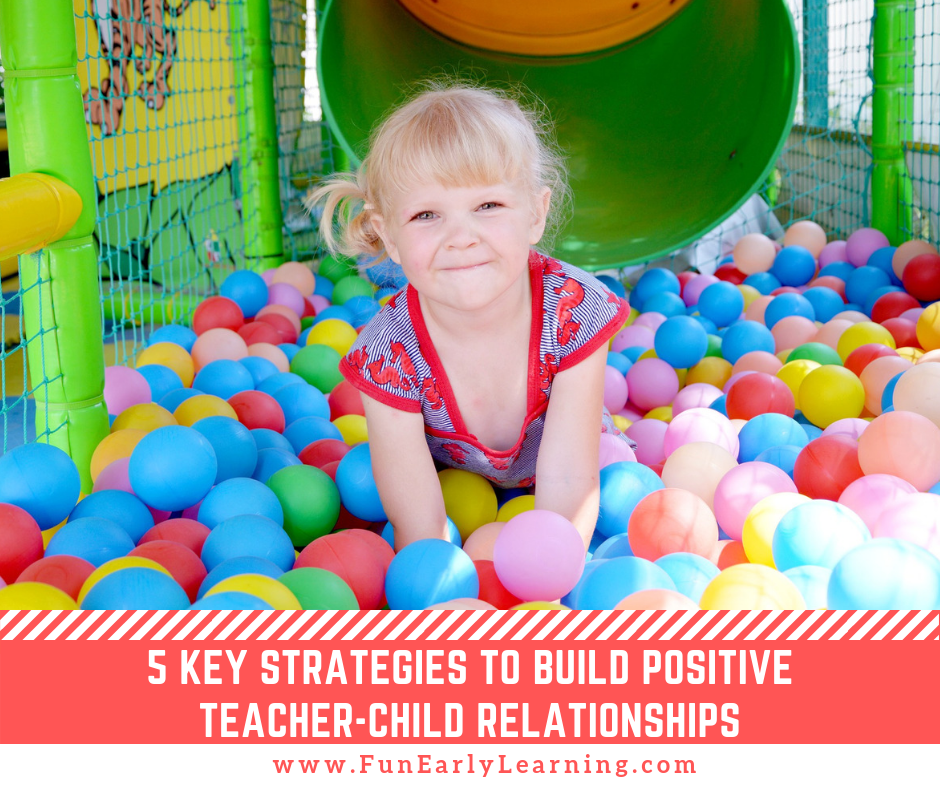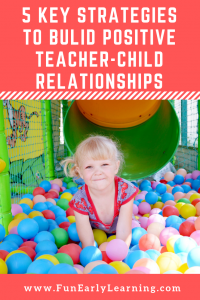
Did you know that teachers are one of the MOST important influences in a child’s life? That is why it is important that every interaction a teacher has with a child is a constructive one. Whether you teach in a school setting or your child at home, it’s important to have a good relationship. Do you know how to build positive teacher-child relationships?
As a teacher, you need to create a safe, caring, and supportive environment for children to feel valued, respected, and important. It is in this type of environment that teachers help children to learn about the world and their place in it. Children LEARN, GROW, AND THRIVE with close, positive relationships with their teachers that are nurtured and full of love, trust, and guidance.

5 key strategies teachers need to implement in order to build positive teacher-child relationships
1. Get to Know Each Child Individually
- Don’t just focus on getting through the academic material.
- Make a conscious effort to get to know each child – their interests and hobbies, things they do outside of school, who they look up to in their family, their pets, etc.
- Taking the time to talk to children about themselves instead of just academics goes a long way in building a strong relationship.
2. Express Empathy, Comfort, and Safety
- Help children to feel that you understand their thoughts, feelings, and emotions. As a result this helps strengthen the bond between you (the teacher) and the child, reinforces trust, and helps the child feel SAFE and cared for.
- If a child becomes upset, comfort them by getting down on their level and giving them a hug or holding them, make eye contact, use simple language that is nonjudgmental, and acknowledge what they are saying. Redirect the child’s feelings to more positive ones (i.e., discuss fun activities for the day and get the child’s thoughts on what they’d like to do).
3. Have a Positive Attitude
- It is very important for teachers to always have a POSITIVE ATTITUDE. Children look to you for examples on how they should behave and react in all situations. Therefore having a positive attitude creates a positive classroom!
- Be aware of your attitude, mood, demeanor, and words to make sure you are remaining calm, positive, supportive, excited, and caring at all times.

4. Set Expectations, Encourage & Support
- Children perform and behave better when they have clear guidelines of what is expected of them. Set high standards for what you expect out of children with their schoolwork and behavior. Explain it to them in words that they can easily understand. Pictures are a great way to show them too!
- In early education, children often need to be reminded of what is expected of them. You, as a teacher, need to support and encourage children to reach their goals. When they try their best, improve, and reach their goals, congratulate them, talk to them about what a great job they have done, and how you are proud of what they have achieved.
5. Join in Activities and Play

- Joining in children’s play is an essential part of developing a positive teacher-child relationship. When you join in children’s free play, the child needs to initiate the play not the teacher. If a child is playing with the kitchen set, the teacher should ask the child what they would like them to play (mother/daughter, teach party, etc).
- You can offer suggestions to the children to further their play. For example, if the child wants to have a picnic at the park, you could ask what food they are going to bring or how they are going to get there.
- Free play is PLAY with PURPOSE and the PERFECT opportunity to engage children in further learning. For example, if a child is building a tower with blocks you could count all of the blocks in the tower with them. Children can create a pattern out of the blocks, talk about colors and shapes. As a result, this keeps learning fun for the child and helps them to make connections to the real world.
Every moment is an opportunity for teachers to build and strengthen their relationships with children. Therefore getting to know children; expressing empathy, comfort, and safety; having a positive attitude; setting expectations; encouraging and supporting children; and joining in free play are all key strategies for creating positive teacher-child relationships in school.



I agree with joining in their activities. It is a good way of making them feel like you are one of them.